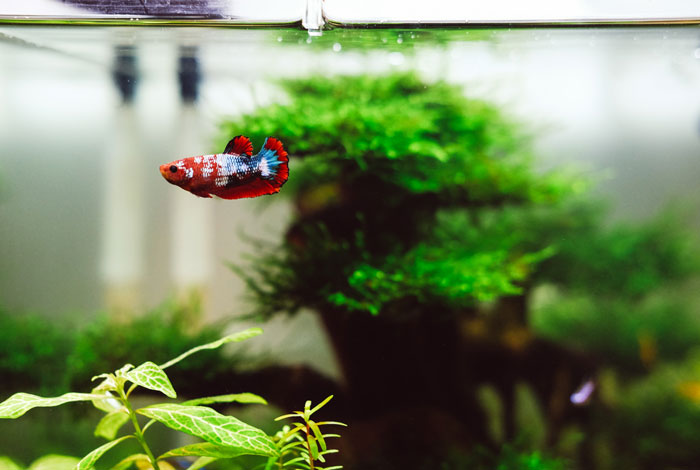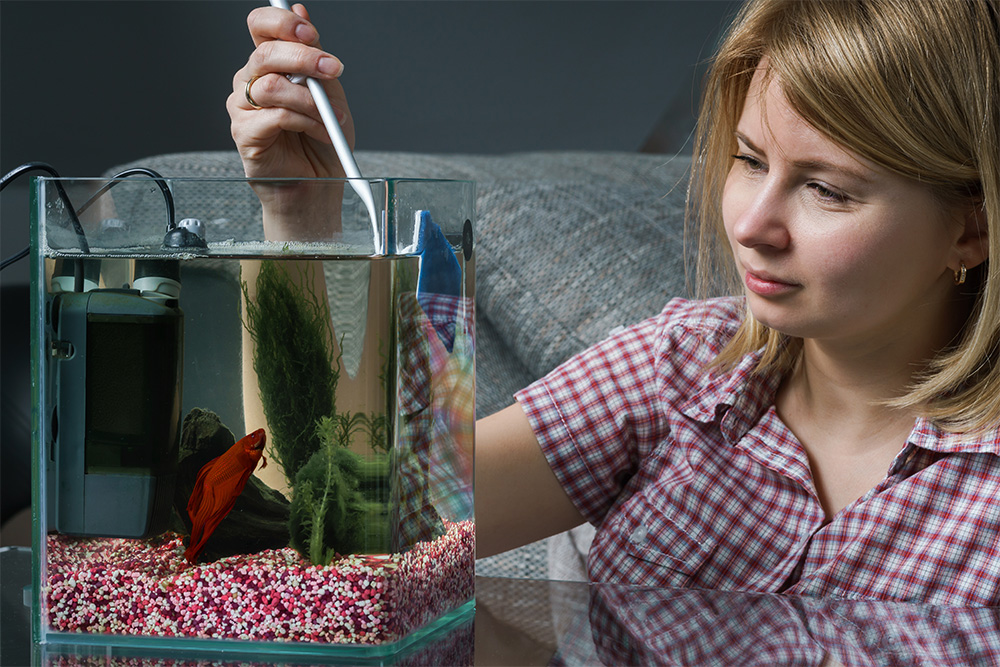Considering buying a betta fish? In this betta fish care guide, we’ll cover everything you’ll need to know about your betta, how to set up a betta tank, what to feed your betta, and more.
Ready? Let’s get started!
The rapid pace of our lives today isolates us from the tranquil beauty of the natural world. Betta tank setups offer tranquility in a unique way that requires minimal care. There are a variety of small or nano rimless aquariums that are perfect for your desk, counter, or nightstand.
These miniature works of “living art” can be filled with live plants, fish, and invertebrates, bringing hours of enjoyment to anyone observing. Your miniature aquarium will quickly become a conversation starter and educational tool among your friends and family. As always, you can depend on us for the best product recommendations and responsible methods to care for your aquatic pets. The perfect betta rimless aquarium houses both plants and livestock.
Plants will add a more natural look while maintaining your water quality keeping your betta healthy. Look for a plant with broad, sturdy leaves that your betta can rest on. Choose low-light plants that will thrive in your betta bowl or make sure you have a better LED light. Mystery snails and freshwater shrimp are excellent choices for algae control.
About the Betta Fish
The betta fish (Betta splendens), or the Siamese Fighting fish can live up to 3 years of age. On average, this fish grows up to 3 inches long.
If you’re considering caring for a betta, keep in mind that you should only have one male in a tank. You can keep multiple females without males in a heavily planted aquarium that is larger (above 5 gallons). This is called a sorority. Male betta with a good temperament can live with other peaceful community fish – just be aware that if it starts to show signs of aggression, you’ll need to remove it from the community tank.
Some good fish species to add to your tank along with your betta are small tetra species, rasboras, and corydoras.
Other Inhabitants That Do Well With Bettas:
- • Tetras and smaller community fish
- • Snails
- • Freshwater shrimp
Read More: Top Betta Fish Tank Mates

Getting Started: Setting Up Your Betta Tank
Ready to get started with betta fish care? The first question you’ll need to ask is “What size tank do I need to get to make a betta happy?” There is a lot of advice out there about what the best tank size is for your betta. However, in order to ensure your betta is happy and thrives (not just survives) in their new environment, you’ll need to purchase a 1-gallon tank (or larger). Remember, you will need a filter and smaller aquariums will need more frequent water changes.
To start setting up your betta tank, you’ll need an aquarium, stand or somewhere to place the tank, lighting, a filter, and more.
The Essentials:
- • Small container or aquarium – Provides a home for your fish
- • Gravel – Adds decoration to the aquarium and a substrate for plant roots
- • Plants – Give fish a hiding place; live plants help water quality
- • Decorations – Give fish a hiding place; helps fish feel secure
- • Dechlorinator/Water Conditioner – Prepares tap water for use; removes toxic chlorine
- • Filtration – Internal sponge filters or powered filters work well. Small canister filters and hang on filters are a step up.

Betta Aquarium & Stand
- • Single Betta vs Community Fish – Are you planning to have lots of community fish along with your betta? You’ll need to make sure your aquarium has 1/2 gallon of water for every inch of adult fish. This is a general guide as with proper filtration, live plants and water changes, larger numbers are possible.
- • What to Put in Your Tank – To start, you’ll want to layer one to two inches of gravel or substrate on the bottom of the tank. Prior to placing the gravel in the tank, be sure to rinse out the gravel. Some gravels and aquasoil (planted substrate) should not be rinsed – see instructions on the bag. Check out some aquascaping techniques here for a beautiful betta tank!
- • Decorate Your Tank – Have fun decorating your betta tank with fish décor, plants, rocks, and other objects. Before adding to the aquarium, be sure to rinse everything first. Once complete, finish by filling the tank the rest of the way.
Filtration
When setting up your betta tank, you’ll also need to consider an aquarium filter.
Tips for Filtration:
Your betta fish filtration should process the aquarium water three to five times an hour. For example, in the case of a 20-gallon tank, you’ll need a filter that can process a minimum of 60 gallons of water per hour. When it comes to choosing a filter be sure and lean on the side of larger not smaller. Manufacturers over rate their filters.
Heating & Lighting
How should I heat and light my betta fish tank? To get started with heating and lighting, you’ll first want to know that bettas are tropical fish that need to live in an environment that’s between 74 and 82 degrees Fahrenheit.
Tips for Heating & Lighting:
- • Use an aquarium heater sized properly. For smaller aquariums, Fluval and Lifegard make excellent preset heaters. They have thermostats but are fixed at a set temperature. Adjustable models from Oase are the best of those types.
- • Do not purchase a heater without a preset or adjustable thermostat. This type of heater will sometimes cost less and is smaller but can cause problems including overheating which can kill the fish.
- • Place the heater near good water flow or the filter so that it distributes the warmed water effectively.
Steps for Setting Up your Aquarium:
- Clean the aquarium thoroughly with water. Do not use soap or any other chemical.
- Lay out the substrate/gravel and any other decorations.
- Add live plants to the aquarium keeping them moist with a spray bottle as you plant.
- Fill the container with water.
- Add a water conditioner, such as Nano Complete
- Float fish bag in aquarium, wait 10 minutes.
- Add a small volume (10% of the bag’s volume) of aquarium water to the bag. Care should be taken to keep bag water out of the aquarium.
Adding the Betta to the Aquarium
Tip – clip the bag to the side of the aquarium with a clothes pin.
- After 10 minutes, add another small volume of water as above.
- Pour off as much water as possible into a bucket. Gently slide fish into the aquarium. Keep bag water from entering the aquarium.
Please note: The chemical balance in your fish tank will change with every new fish you add. As a result, be sure to check your aquarium water’s pH, ammonia, and nitrite levels regularly.
Feeding Your Betta
Begin feeding the fish the day after you introduce it to the aquarium. Your betta has a very specific diet. Be sure to use a food that is specifically designed for bettas. You should also supplement this diet with freeze-dried or frozen bloodworms. Live blackworms also make an excellent treat. Feed 4-5 pellets or worms once a day. Remove any uneaten food to avoid fouling your water.
Food Options:
- • Atison’s Betta Food (ON8303)
- • Betta Cuisine
- • Freeze-dried bloodworms (SF4775)
- • Bettagran Color Enhancing Granules for Bettas
- • Frozen bloodworms
- • Live Black Worms – great for a treat and finicky eaters
- • Shop betta fish food on SevenPorts today!

Keeping Your Betta Healthy
Keep your betta healthy with an appropriately-sized tank, regular feeding, and routine tank maintenance. In the instance your betta fish displays some unusual behavior, or signs of illness, you’ll want to check with us for what to do. Some signs of illness to look out for include:
- • Decreased appetite
- • Abdominal swelling
- • Fins clamped to the sides
- • Scraping body on rocks
- • Inflamed or discolored skin/fins
Use Almond leaves or Almond Leaf extract to help prevent fish disease. Here is an article about almond leaves: The Hidden Benefits of Almond Leaves. In summary, DO NOT SKIMP on betta fish care. You’ll want to purchase a bigger tank, purchase quality equipment, and good foods for your betta. Be sure to educate yourself as much as possible on the proper care of a betta fish.
How to do Water Changes:
- • Use a gravel cleaner to remove water and clean the gravel, siphoning it down 25-70%. Larger water changes are better for small aquariums.
- • Fill the container with water that is the same temperature as the aquarium water and treat with a water conditioner, such as Nano Complete to dechlorinate and condition the water.
- • Items that will help with cleaning and doing water changes:
- • Tweezers
- • Gravel Cleaner
- • Hydra Aquatics Feeder and Cleaner to help remove particles.
Betta Fish Care FAQs
There are many factors that go into keeping your betta fish happy. Be sure and have a filter, heater, aquarium decorations for plenty of places to hide, water between 74 and 82 degrees Fahrenheit, quality fish food, and sufficient lighting.
There is a lot of misinformation about betta fish care on the internet. This ever-popular fish is known for being an “easy” pet, however it still has plenty of needs, just like many other species of small fish. While there are no “easy” pets, it is true that bettas are easier to care for than some other types of fish. They are both a great start for beginners and a fun species for experts to care for. Just be sure to carefully research everything your betta needs before rushing out and buying one.
No. Bettas are highly territorial fish that should NOT be in the same tank with other bettas. Depending on their temperament, however, some betta fish will do fine in peaceful community tanks with other small fish.
Lighting for your betta fish tank may not necessarily be a critical feature of your aquarium setup, however, your fish won’t thrive at all in a dimly lit room. If you have aquarium plants, you absolutely will need to use a light. Live plants help your betta thrive. It is recommended to invest in quality lighting for your betta and plants.

Fun Facts About Bettas:
- • Bettas prefer warm water! If your fish seems lifeless, you should invest in a small, submersible heater.
- • Male bettas build a bubble nest at the surface of the aquarium. This means that they are comfortable and happy with their environment and would breed if given the opportunity!
- • A Bettas’ lifespan is typically around 3 years. They are around a year old when you purchase them.
- • Betta fish can breathe fresh air. They have a labyrinth organ that allows them to swim to the surface and take in oxygen directly from the air.
Further Reading:
Aquarium Botanicals: Guava Leaves
The Hidden Benefits of Almond Leaves
Eight Best Algae Eaters for Your Planted Tank

